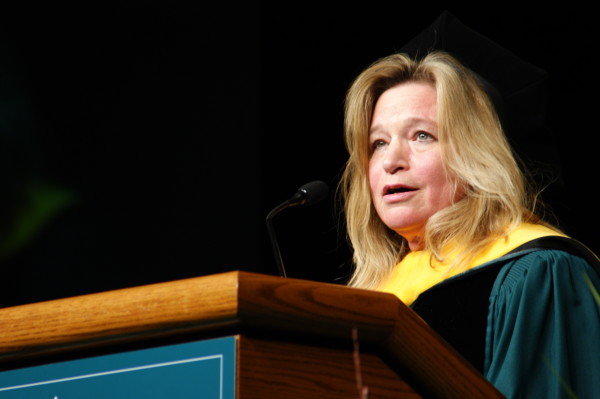When she was four, she saw her first rocket launch. As a teen, she heard Carl Sagan wax poetic about Martian rocks. For Ellen Stofan ’83, the path to becoming Chief Scientist of the National Aeronautics and Space Administration (NASA) was a long time coming.
“I was this kid who always picked up rocks, and I wanted to be a planetary geologist from the time I was fourteen. It was very weird,” Stofan said.
“It was sunny and there were boys all over the place, and I thought ok, this is for me!” Stofan said. “It’s ridiculous to say that I was swayed by a sunny day in Williamsburg, but I really was.”
Stofan grew up in Ohio, where her father, a NASA engineer, worked for the Glenn Research Center. When Stofan was a junior in high school, her family moved to northern Virginia. There, Stofan’s father worked at NASA Headquarters, where she works now.
“I always thought I would go to university in Ohio, because everyone I knew went to university in Ohio. When we moved to Virginia, I thought, ‘Oh, well maybe I’ll go look at that William and Mary place,’” Stofan said.
Originally, Stofan was looking at women’s colleges and wasn’t a fan of the College of William and Mary on the gray winter day she initially visited. It was a later spring tour that convinced Stofan to apply early decision.
“It was sunny and there were boys all over the place, and I thought ok, this is for me!” Stofan said. “It’s ridiculous to say that I was swayed by a sunny day in Williamsburg, but I really was.”
After moving into Yates Hall her freshman year, Stofan immersed herself in the geology department, finding guidance from her professors and fellow students. As chief scientist at NASA, Stofan spends a lot of time speaking to students and women in science, technology, engineering, and math (STEM) fields about their opportunities while in school and at the outset of their careers. Stofan said she made the transition smoothly from the science-supportive atmosphere of her home to the geology department at the College.
“The department here at William and Mary was very tight knit, amazingly supportive; we had fun, and I felt like I got an excellent grounding in geology, which is what I really wanted,” Stofan said. “Before I went off to study other planets I wanted to understand this one, and I felt like that’s what I got.”
“I did jump over the [Governor’s Palace] wall,” Stofan said. “I jumped over the wall more than once. [And] the squirrels, they used to drive me crazy when I was here. I was convinced they were after me because twice I ran over a squirrel’s leg on my bike.”
Between geology field trips, Stofan rushed Pi Beta Phi her sophomore year and spent her free time biking out to Carter’s Grove Plantation and going to basketball games.
“I met my husband here, so he and I started dating my junior year, and that was great,” Stofan said. “He was in Theta Delta Chi, which I don’t think exists anymore.”
While at the College, Stofan tested her boundaries by going on geology trips to Utah and Colorado, as well as working for NASA and the Smithsonian Air and Space Museum over the summers, to make sure the career she chose when she was 14 was right for her. But Stofan said it is the College’s on-campus traditions that still stand out for her.
“I did jump over the [Governor’s Palace] wall,” Stofan said. “I jumped over the wall more than once. [And] the squirrels, they used to drive me crazy when I was here. I was convinced they were after me because twice I ran over a squirrel’s leg on my bike.”
Before becoming NASA’s Chief Scientist in 2013, Stofan received her master’s and Ph.D. in planetary geology from Brown University. Most recently, she worked on a project proposal to send a boat to Titan, a moon of Saturn’s that has seas essentially composed of liquid gasoline. The proposal was ultimately not funded three years ago and cannot fly again until the mid-2030s. Three months later, she was asked to interview for the Chief Scientist position.
“I had this idea where you start in a career, and you’re going to get one great job after another until you are at the absolute height of your career and then you retire,” Stofan said. “And it’s not like that. You have great highs, and then that project ends and you’re like, what am I going to do next? … It ebbs and flows.”

